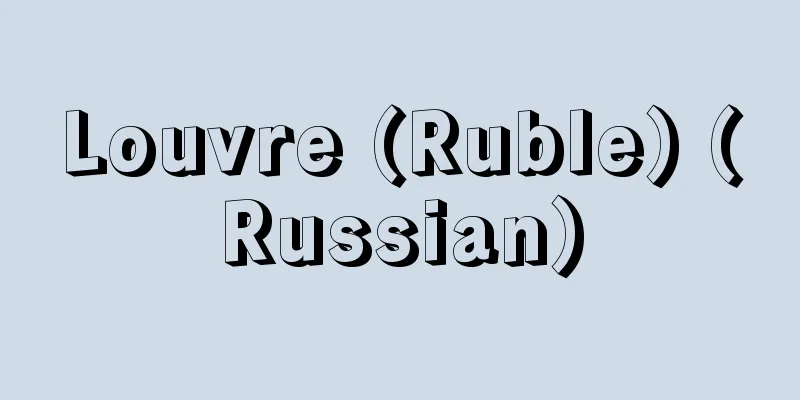Louvre (Ruble) (Russian)

|
The currency of Imperial Russia, the Soviet Union, and the present Russian Federation. The ruble originates from the word "silver piece of a certain value." 1 ruble = 100 kopecks (singular: kopeyka). [Hara Makoto] Imperial periodThe ruble had been in circulation in the form of silver bullion since around the 13th century, but was adopted as the currency unit when Ivan IV ascended to the throne in 1547. Later, under Peter the Great in 1704, ruble silver coins with a pure silver weight of 27.3 grams were minted as official coins, and it was decided that 1 ruble would be worth 100 kopecks, establishing the world's first decimal currency system. The silver standard was introduced in 1839, but inflation occurred during the Crimean War (1853-1856), and the Russo-Turkish War (1877-1878) also led to chaos in the monetary system. Under these circumstances, the gold standard was established by Finance Minister Witte in 1897, and the weight of 1 ruble = 774.234 milligrams of pure gold was decided. However, when World War I began in 1914, the gold standard was also suspended by law on July 27 of the same year. [Hara Makoto] After the RevolutionAfter the October Revolution of 1917, the Soviet government issued a large amount of inconvertible paper money, which caused severe inflation. Around 1920, when the civil war and foreign military intervention had almost ended, the Soviet government introduced the New Economic Policy (NEP) and made an effort to reform the currency. First, in November 1921, the currency was denominated by 1/10,000 (the name of the currency unit was devalued by, for example, 1/10 or 1/100 and replaced with a new name), and in October 1922, it was denominated by 1/100. In parallel with this, Gosbank was established as the central bank in 1921, and from November 1922, it issued banknotes called chervonets, which were equivalent to 10 rubles of the old gold coin. These banknotes were backed by precious metals up to 25% of the amount of banknotes issued. Furthermore, in order to withdraw the government's inconvertible banknotes, which were still being issued without limit, in February 1924 the government issued new government notes equal to one-tenth of a chervonets, and in March of the following year decided to exchange the new government notes at a rate of 1 ruble for 50,000 old government notes, in an attempt to withdraw the old notes. In the post-revolutionary Soviet Union, between 1921 and 1924, there were two denominations and one currency reform, resulting in a total denomination of 1/500 billion. In 1935, in order to stabilize the ruble's external value, it was linked to the French franc, with 1 ruble = 3 francs, and this was applied to all external transactions from April the following year, 1936. When France left the gold standard in June 1937, it was linked to the US dollar, with 1 US dollar = 5.3 rubles. [Hara Makoto] After World War IIThe Soviet Union continued to suffer from inflation after World War II, so a currency reform was carried out in 1947. Under this reform, a new ruble was issued, cash was exchanged at a rate of 10 old rubles to 1 new ruble, salaries and pensions were exchanged at a rate of 1 old ruble to 1 new ruble, and preferential rates were applied to deposits ranging from 1 old ruble to 1 new ruble to 2 old rubles to 1 new ruble depending on the amount. In 1950, the ruble was abolished from its link to the US dollar and a new gold parity was established, with 1 ruble = 222.168 milligrams. This resulted in a 32.5% revaluation of the ruble to the US dollar, making it 4 rubles to 1 US dollar. In 1961, the ruble's gold parity was changed to 987.42 milligrams and it was also devalued by 10. As a result, the new ruble-to-US dollar exchange rate was 0.9 rubles to 1 US dollar. After the International Monetary Fund's (IMF) fixed exchange rate system collapsed and major currencies such as the US dollar entered floating exchange rates, the official exchange rate of the ruble became flexible and was announced monthly by the Soviet authorities. In September 1982, it was 1 US dollar = 0.734 rubles. During the Soviet era, the ruble was different from the major currencies of free economic zones in that it was not convertible against foreign currencies, and external transactions themselves were conducted on a government basis, so the exchange rate had little significance. External balance adjustments were made through adjustments to economic and trade plans and the sale of gold reserves on the market. In 1949, Comecon (Council for Mutual Economic Assistance) was established among Eastern European countries, becoming a multilateral settlement mechanism within the Soviet Union and Eastern European zone, with the "transferable ruble" becoming the settlement unit. However, this was not convertible and could not be used for settlements outside the region. In this way, the ruble was the settlement currency within the former socialist Eastern European zone, and played the role of a unit of calculation of value. [Hara Makoto] Russian Federation RubleWhen the Soviet Union collapsed at the end of 1991, the 15 member republics became independent, and the remaining 12 republics, excluding the three Baltic states, formed the CIS (Commonwealth of Independent States). After the collapse of the Soviet Union, Russia suffered from severe inflation and economic turmoil, and the ruble continued to depreciate as the budget deficit grew, but the former Soviet republics continued to use the ruble after independence, and many of them used their own coupons in addition. The three Baltic states, Ukraine, and Belarus then introduced their own currencies in 1992, and the Russian Federation issued new Russian ruble banknotes in July 1993, ceasing the use of the former Soviet ruble. As a result, other CIS countries also gradually began issuing their own currencies from 1993 onwards, and publishing their exchange rates against the US dollar. Russia abolished its planned economy at the beginning of 1992 and moved to a market economy system. In June, it joined the IMF and began receiving financial assistance from Europe, the United States and Japan. The exchange rate of the ruble moved from the fixed exchange rate system of the Soviet era to a managed floating exchange rate system, and the Central Bank of Russia (CBR) announced the central bank official rate based on the actual market value of the Moscow interbank foreign exchange market (MICEX). On the first day, July 1, it was 125.26 rubles to the US dollar. However, with the rapid inflation, the ruble exchange rate plummeted to 1,247 rubles at the end of 1993, and even though a target range against the US dollar was adopted in July 1995, it fell to 5,960 rubles at the end of 1997. Therefore, in early 1998, a 1/1000 denomination was implemented, starting at 1 US dollar = 6 rubles, but when the Russian financial crisis occurred in August, it fell to 28 rubles at the end of 1999 and 32 rubles at the end of 2001. The cause of the financial crisis was the simultaneous withdrawal of investments and loans from Russia by foreign capital, wary of the deterioration of Russia's balance of payments due to the sudden drop in crude oil prices, following the Asian currency crisis of 1997. This caused a sharp decline in foreign currency reserves, and the Russian government, faced with a default on its foreign debt, declared a massive 32.8% devaluation of the ruble, a suspension of short-term government bonds and foreign exchange market transactions, and a moratorium on private foreign debt. As a result, many Russian commercial banks went bankrupt, and Western financial institutions and hedge funds that had made large investments and loans to Russian government bonds and commercial banks suffered huge losses, causing major repercussions around the world. However, supported by a large devaluation of the exchange rate and the subsequent rise in crude oil prices, Russia's balance of payments improved rapidly and foreign exchange reserves increased, resulting in the ruble exchange rate stabilizing. In 2005, reflecting the increase in transactions with the European Union (EU), the CBR changed the ruble exchange rate from pegged to the US dollar to a basket of US dollars and euro currencies, and since then, it has fluctuated at around 27-25 rubles per US dollar. However, in the second half of 2008, the country was hit by the outbreak of conflict in Georgia and another sudden drop in crude oil prices, and by the start of 2009 it had fallen to around 30-35 rubles. Russia is a major oil and gas resource country, but in order to stabilize the ruble, it is necessary to move away from an overly resource-dependent economy through economic restructuring reform, modernize the financial system, and stabilize the political situation. [Azusa Oshima] [References] | | | | | |Source: Shogakukan Encyclopedia Nipponica About Encyclopedia Nipponica Information | Legend |
|
帝政ロシア、ソビエト連邦および現在のロシア連邦の通貨単位。ルーブルは、語源的には「一定の価値をもつ銀片」という意味である。1ルーブル=100コペークкопеек/kopeek(単数形はコペイカкопейка/kopeyka)。 [原 信] 帝政時代ルーブルは、13世紀ごろから銀塊の形で流通に用いられていたが、1547年イワン4世の即位に際して通貨単位として採用された。その後1704年、ピョートル大帝のもとで、27.3グラムの純銀量目をもつルーブル銀貨が正規の鋳貨として鋳造され、また、1ルーブルを100コペークとすることが定められて、世界で最初の十進法通貨制度が成立した。 1839年に銀本位制が導入されたが、クリミア戦争(1853~1856)によるインフレーションが生じ、さらにロシア・トルコ戦争(1877~1878)の影響も加わって、通貨制度は混乱した。このような状況のもとで、1897年蔵相ウィッテによって金本位制が確立され、1ルーブル=純金774.234ミリグラムの量目が決定された。しかし、この金本位制も、1914年に第一次世界大戦が始まると、同年7月27日の法律によって停止されることになる。 [原 信] 革命後1917年の十月革命後、ソビエト政府が不換紙幣を濫発したため、激しいインフレーションが起こった。1920年ごろ、内戦や外国の軍事干渉がほぼ終結すると、ソビエト政府はネップ(新経済政策)の導入に踏み切り、通貨改革に努力した。まず、1921年11月に1万分の1のデノミネーション(貨幣単位の呼称を、たとえば10分の1とか100分の1とか切り下げて新しい名称にかえること)を、翌1922年10月には100分の1のデノミネーションを実施した。また、これと並行して、1921年に中央銀行としてゴスバンクを設立、翌1922年11月から旧金貨10ルーブルと等価のチェルボーネツчервонец/chervonetsという銀行券を発行した。これは、銀行券発行高の25%まで貴金属の裏付けをもつものであった。さらに、依然として無制限に増発されていた政府の不換紙幣を回収すべく、1924年2月に政府は、1チェルボーネツの10分の1に等しい新政府紙幣を発行、そして翌3月には新政府紙幣1ルーブル=旧政府紙幣5万ルーブルの割合で交換することを決定し、旧紙幣の回収を図った。 このような、革命後のソ連では、1921年から1924年にかけて、2回のデノミネーションと1回の通貨改革で、合計500億分の1のデノミネーションが行われたことになる。 1935年、ルーブルの対外価値を安定させるため、フランス・フランにリンクさせることとなり、1ルーブル=3フランとし、翌1936年4月からすべての対外取引に適用された。1937年6月にフランスが金本位を離脱すると、今度は米ドル・リンクとし、1米ドル=5.3ルーブルとなった。 [原 信] 第二次世界大戦後ソ連は、第二次世界大戦後もまたインフレーションにみまわれたので、1947年に通貨改革が行われた。それは新ルーブルを発行し、現金は旧10ルーブルに対し新1ルーブルの割合で交換し、給料や年金などは旧1ルーブル対新1ルーブル、預金は額に応じて旧1ルーブル対新1ルーブルから旧2ルーブル対新1ルーブルまでの優遇レートを適用するというものであった。 1950年にはルーブルの対米ドル・リンクを廃止し、新たに金平価を設定、1ルーブル=222.168ミリグラムとした。これによって対米ドル相場は32.5%の切上げとなり、1米ドル=4ルーブルとなった。さらに1961年にはルーブルの金平価を987.42ミリグラムに変更すると同時に、10分の1のデノミネーションを実施した。この結果、新しいルーブルの対米ドル相場は1米ドル=0.9ルーブルとなった。 その後、国際通貨基金(IMF)の固定相場体制が崩壊し、米ドル以下主要通貨が変動相場制に入ると、ルーブルの公定相場は弾力的に変更されるようになり、ソ連当局によって毎月公表された。1982年9月では1米ドル=0.734ルーブルであった。 ソ連時代のルーブルは、自由経済圏の主要通貨とは異なり、外貨に対する交換性がなく、また、対外取引そのものも政府ベースで行われるため、為替(かわせ)相場のもつ意味は小さかった。対外収支の調整は、経済・貿易計画の調整と、保有金の市場売却によって行われていた。なお、1949年、東欧諸国の間にコメコン(経済相互援助会議)が設立され、ソ連・東欧圏内の多角決済機構となり、「振替ルーブル」が決済単位となった。しかしこれは交換性がなく、域外との決済には利用できなかった。このようにルーブルは、旧東欧社会主義圏内での決済通貨であり、価値の計算単位の役割を果たしていた。 [原 信] ロシア連邦のルーブル1991年末ソビエト連邦が解体すると、加盟15共和国はそれぞれ独立し、バルト三国を除く12の共和国はCIS(独立国家共同体)を結成した。ソ連崩壊後のロシアは激しいインフレーションと経済混乱にみまわれ、財政赤字の増大とともにルーブルは減価を続けたが、独立後の旧ソ連各共和国はルーブルの使用を続け、多くは独自のクーポンを併用した。そしてバルト三国、ウクライナ、ベラルーシは1992年から独自通貨を導入、ロシア連邦は1993年7月新ロシア・ルーブル紙幣を発行、旧ソ連ルーブルの使用を停止した。そのため他のCIS諸国も1993年以降漸次自国通貨を発行、それぞれ対米ドル為替相場の公表を開始した。 ロシアは1992年初より計画経済を廃止、市場経済システムに移行するとともに6月にはIMFに加盟、欧米日からの金融支援も開始された。ルーブルの為替相場は、ソ連時代の固定的為替相場制から管理された変動為替相場制に移行し、ロシア中央銀行(CBR)はモスクワの銀行間外国為替市場(MICEX)の実勢に基づき中央銀行公表レートを発表、初日の7月1日は1米ドル=125.26ルーブルであった。しかしルーブル為替相場は激しいインフレーションの進行とともに、1993年末には1247ルーブルへと急落、さらに1995年7月からは変動幅をもつ対米ドル目標相場圏方式を採用したが、1997年末には5960ルーブルへと下落した。そのため1998年初めに1000分の1のデノミネーションを実施、1米ドル=6ルーブルでスタートしたが、8月ロシア金融危機が発生すると、1999年末は28ルーブル、2001年末には32ルーブルにまで下落した。金融危機発生の原因は、1997年のアジア通貨危機に続いて、原油価格の急落によるロシアの国際収支の悪化を警戒した外資が、一斉に対ロシア投融資の引揚げを開始したことによる。そのため外貨準備が急減し、対外債務のデフォルト(債務不履行)に直面したロシア政府は、ルーブルの32.8%の大幅切下げとともに、短期国債および外国為替市場取引の停止と民間対外債務のモラトリアム(返済棚上げ)を宣言した。その結果多数のロシア商業銀行が破綻(はたん)するとともに、ロシア国債や商業銀行に大量に投融資していた西側金融機関やヘッジファンドは巨額の損失を被り、世界的に大きな波紋を引き起こした。 しかし大幅な為替相場の切下げとその後の原油価格の上昇に支えられ、ロシアの国際収支は急速に改善し外貨準備が増大した結果、ルーブル為替相場は安定に向かう。2005年には対ヨーロッパ連合(EU)取引の増大を反映し、CBRはルーブル為替相場決定を対米ドル連動から、米ドル・ユーロ通貨バスケット方式に変更、以後、1米ドル27~25ルーブル前後で推移した。しかし2008年後半、ジョージア(グルジア)紛争発生と再度の原油価格急落にみまわれ、2009年に入ると30~35ルーブル近辺にまで下落している。 ロシアは石油ガス資源大国だが、ルーブル安定化のためには、経済構造改革による過度の資源依存経済からの脱却、金融システムの近代化、そして政治情勢の安定化が望まれる。 [大島 梓] [参照項目] | | | | | |出典 小学館 日本大百科全書(ニッポニカ)日本大百科全書(ニッポニカ)について 情報 | 凡例 |
>>: Lublin - Lublin (English spelling)
Recommend
Household servant
〘Noun〙 Taxes imposed on households in the Middle A...
Yukihira pot - Yukihira pot
A thick ceramic pot, a type of earthenware pot. I...
Coptis chinensis (English spelling) Coptischinensis
…[Nitta Aya]. . . *Some of the terminology that m...
Ordos
In the southern part of the Inner Mongolia Autonom...
House quality - Kajichi
Mortgages of houses in the Edo period. The word &...
Lenin [peak] - Lenin
The main peak of the Zaaraisky Mountains on the bo...
Strike - Uchimaki
〘 noun 〙① A method of offering. Scattering rice. I...
Agenais
Aquitaine is a region in southwestern France, mai...
Ikutachi Hachiman Shrine
This shrine is located in the Ikutate area of Mi...
Kodama [town] - Kodama
An old town in Kodama County in northwest Saitama ...
Sericite - Sericite
Another name for fine white mica. Also called ser...
MS-T5, PLANET-A - MS Stage
...ISEE3 started moving from the Lagrangian point...
Polar
A type of worsted fabric. It is woven in a plain o...
Closely - Closely
A Chinese literati and poet from the late Song an...
Diptera
...A general term for insects that belong to the ...









